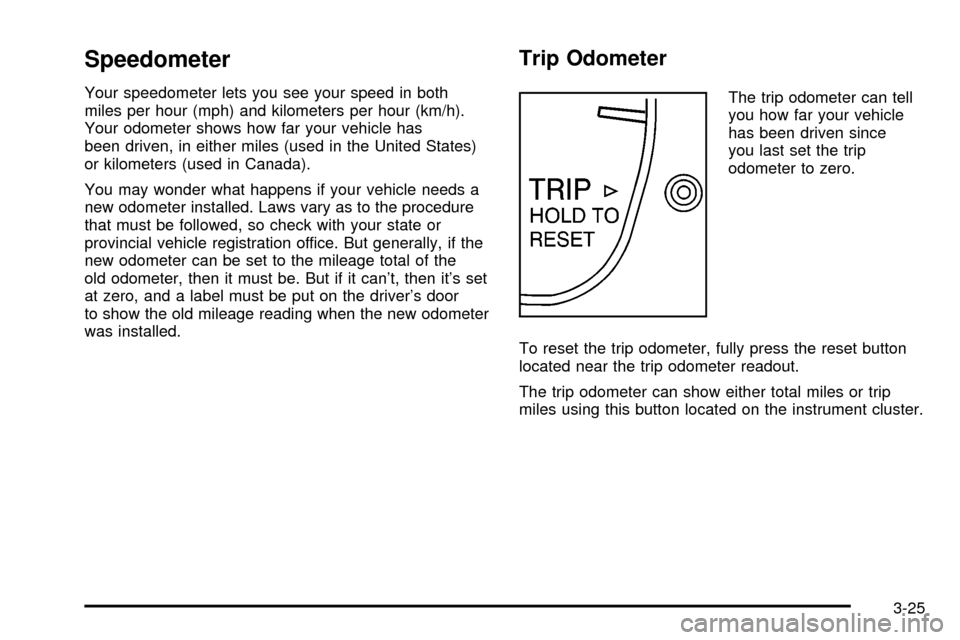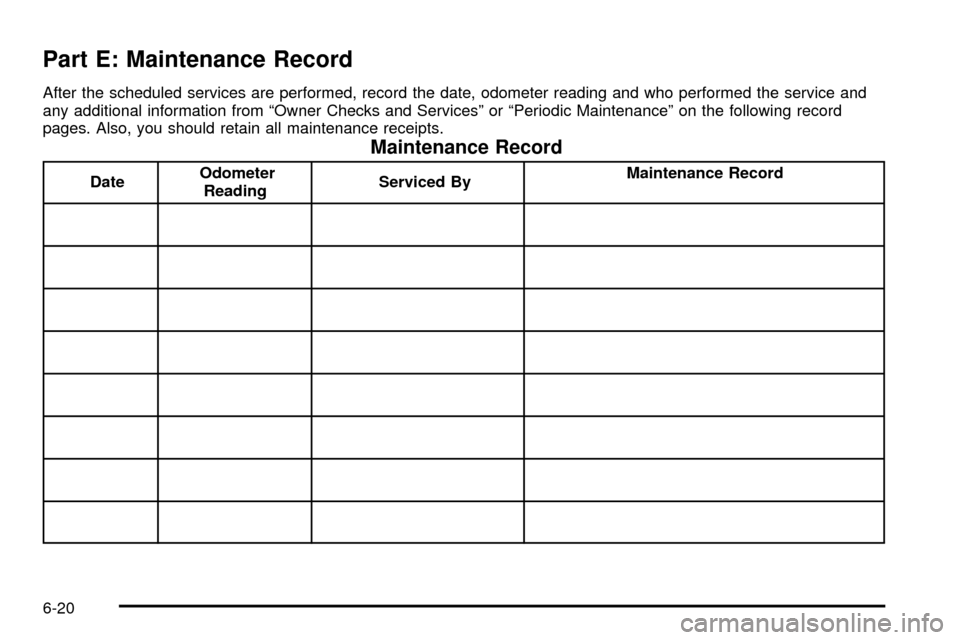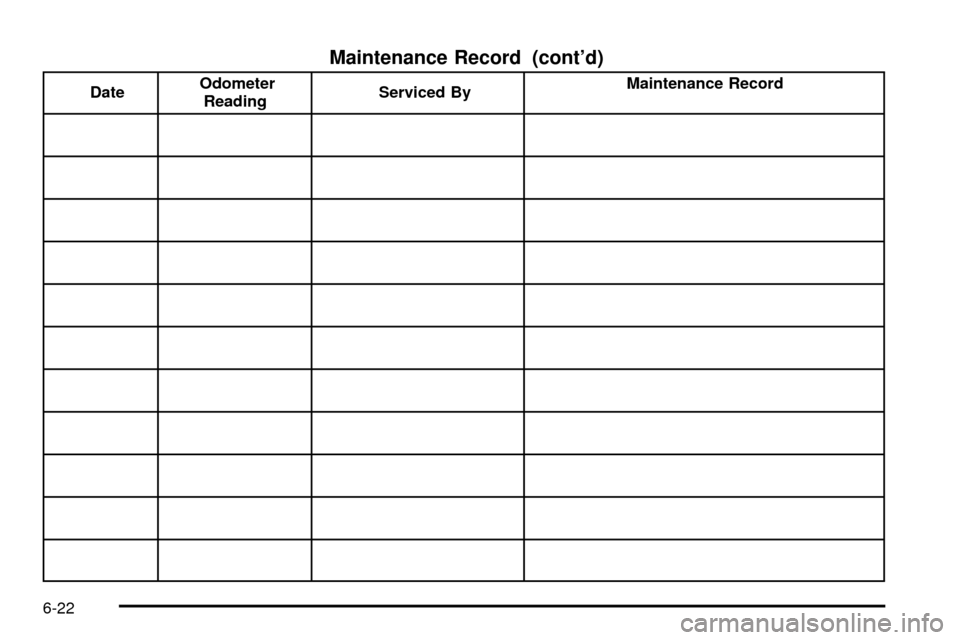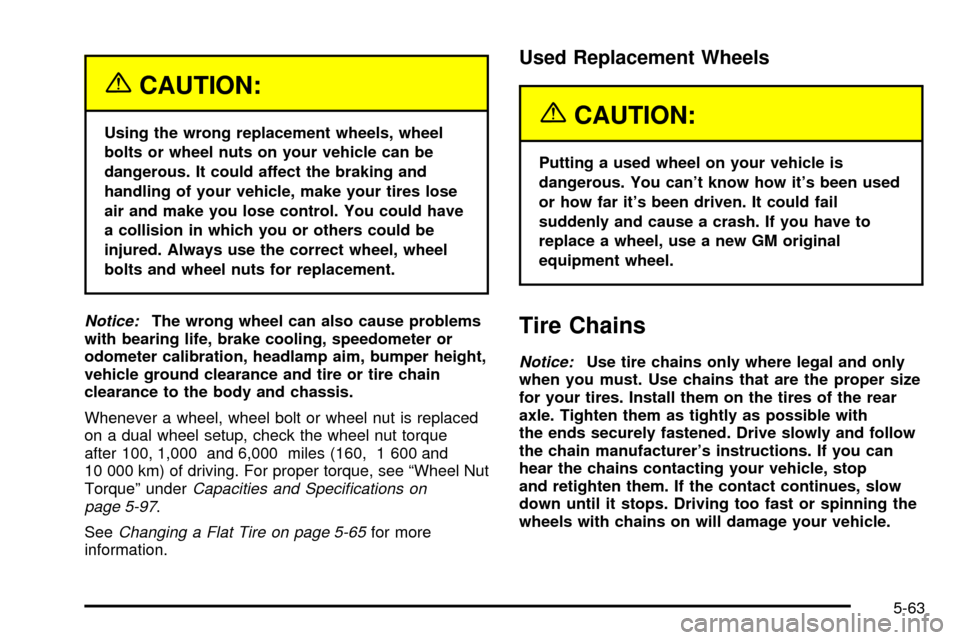2003 CHEVROLET EXPRESS CARGO VAN odometer
[x] Cancel search: odometerPage 143 of 386

Speedometer
Your speedometer lets you see your speed in both
miles per hour (mph) and kilometers per hour (km/h).
Your odometer shows how far your vehicle has
been driven, in either miles (used in the United States)
or kilometers (used in Canada).
You may wonder what happens if your vehicle needs a
new odometer installed. Laws vary as to the procedure
that must be followed, so check with your state or
provincial vehicle registration office. But generally, if the
new odometer can be set to the mileage total of the
old odometer, then it must be. But if it can't, then it's set
at zero, and a label must be put on the driver's door
to show the old mileage reading when the new odometer
was installed.
Trip Odometer
The trip odometer can tell
you how far your vehicle
has been driven since
you last set the trip
odometer to zero.
To reset the trip odometer, fully press the reset button
located near the trip odometer readout.
The trip odometer can show either total miles or trip
miles using this button located on the instrument cluster.
3-25
Page 244 of 386

It is also important to check your oil regularly and keep
it at the proper level.
If the system is ever reset accidentally, you must
change your oil at 3,000 miles (5 000 km) since your
last oil change. Remember to reset the oil life system
whenever the oil is changed. See
Engine Oil on
page 5-13for information on resetting the system.
An Emission Control Service.
Lubricate chassis components with each engine oil
and ®lter change.
Lubricate the front suspension, kingpin bushings,
steering linkage and rear driveline center splines.
See the mileage intervals following for additional
services that may be performed with an engine oil
change and chassis lubrication. After the services are
performed, record the date, odometer reading and
who performed the service on the maintenance record
pages in Part E of this schedule.
7,500 Miles (12 500 km)
qCheck rear/front axle ¯uid level and add ¯uid as
needed. Check constant velocity joints and axle seals
for leaking.
qRotate tires. See
Tire Inspection and Rotation on
page 5-58for proper rotation pattern and additional
information.(See footnote +.)
15,000 Miles (25 000 km)
qInspect engine air cleaner ®lter change indicator. If
necessary, replace the ®lter. If vehicle is driven in
dusty/dirty conditions, inspect ®lter change indicator
at every engine oil change. See
Engine Air
Cleaner/Filter on page 5-17for more information.An Emission Control Service. (See footnote ².)
qCheck rear/front axle ¯uid level and add ¯uid as
needed. Check constant velocity joints and axle seals
for leaking.
qVehicles With GVWR Above 10,000 lbs. Only:
Inspect shields for damage or looseness. Adjust or
replace as required.
This is a Noise Emission Control
Service. Applicable only to vehicles sold in the
United States.
qRotate tires. SeeTire Inspection and Rotation on
page 5-58for proper rotation pattern and additional
information.(See footnote +.)
22,500 Miles (37 500 km)
qCheck rear/front axle ¯uid level and add ¯uid as
needed. Check constant velocity joints and axle seals
for leaking.
qRotate tires. See
Tire Inspection and Rotation on
page 5-58for proper rotation pattern and additional
information.(See footnote +.)
6-6
Page 258 of 386

Part E: Maintenance Record
After the scheduled services are performed, record the date, odometer reading and who performed the service and
any additional information from ªOwner Checks and Servicesº or ªPeriodic Maintenanceº on the following record
pages. Also, you should retain all maintenance receipts.
Maintenance Record
DateOdometer
ReadingServiced ByMaintenance Record
6-20
Page 259 of 386

Maintenance Record (cont'd)
DateOdometer
ReadingServiced ByMaintenance Record
6-21
Page 260 of 386

Maintenance Record (cont'd)
DateOdometer
ReadingServiced ByMaintenance Record
6-22
Page 333 of 386

{CAUTION:
Using the wrong replacement wheels, wheel
bolts or wheel nuts on your vehicle can be
dangerous. It could affect the braking and
handling of your vehicle, make your tires lose
air and make you lose control. You could have
a collision in which you or others could be
injured. Always use the correct wheel, wheel
bolts and wheel nuts for replacement.
Notice:The wrong wheel can also cause problems
with bearing life, brake cooling, speedometer or
odometer calibration, headlamp aim, bumper height,
vehicle ground clearance and tire or tire chain
clearance to the body and chassis.
Whenever a wheel, wheel bolt or wheel nut is replaced
on a dual wheel setup, check the wheel nut torque
after 100, 1,000 and 6,000 miles (160, 1 600 and
10 000 km) of driving. For proper torque, see ªWheel Nut
Torqueº under
Capacities and Speci®cations on
page 5-97.
See
Changing a Flat Tire on page 5-65for more
information.
Used Replacement Wheels
{CAUTION:
Putting a used wheel on your vehicle is
dangerous. You can't know how it's been used
or how far it's been driven. It could fail
suddenly and cause a crash. If you have to
replace a wheel, use a new GM original
equipment wheel.
Tire Chains
Notice:Use tire chains only where legal and only
when you must. Use chains that are the proper size
for your tires. Install them on the tires of the rear
axle. Tighten them as tightly as possible with
the ends securely fastened. Drive slowly and follow
the chain manufacturer's instructions. If you can
hear the chains contacting your vehicle, stop
and retighten them. If the contact continues, slow
down until it stops. Driving too fast or spinning the
wheels with chains on will damage your vehicle.
5-63
Page 384 of 386

T
Taillamps.......................................................5-52
Theft-Deterrent, Radio.....................................3-73
Theft-Deterrent Systems...................................2-19
Passlock
ž...................................................2-19
Throttle System Inspection...............................6-17
Tilt Wheel........................................................ 3-7
Tire In¯ation Check.........................................6-11
Tires.............................................................5-56
Buying New Tires........................................5-60
Chains.......................................................5-63
Changing a Flat Tire....................................5-65
Dual Tire Operation.....................................5-57
If a Tire Goes Flat.......................................5-64
In¯ation -- Tire Pressure...............................5-56
Inspection and Rotation................................5-58
Uniform Tire Quality Grading.........................5-61
Wheel Alignment and Tire Balance.................5-62
Wheel Replacement.....................................5-62
When It Is Time for New Tires......................5-59
To Use the Engine Coolant Heater....................2-23
Top Strap Anchor Location...............................1-50
Top Strap......................................................1-48
Torque Lock...................................................2-28
Total Weight on Your Vehicle's Tires..................4-39
Tow/Haul Mode Light.......................................3-38
Tow/Haul Mode...............................................4-32Towing..........................................................4-29
Recreational Vehicle.....................................4-29
Towing a Trailer..........................................4-31
Your Vehicle...............................................4-29
Trailer Brakes.................................................4-40
Trailer Wiring Harness.....................................4-44
Transfer Case................................................5-46
Transmission Operation, Automatic....................2-24
Transmission, Transaxle, Transfer Case Unit
Repair Manual............................................7-10
Transmission..................................................5-19
Fluid, Automatic...........................................5-19
Transportation Options...................................... 7-7
Trip Odometer................................................3-25
Turn and Lane Change Signals.......................... 3-8
Turn Signal/Multifunction Lever........................... 3-7
Turn Signals When Towing a Trailer..................4-42
U
Underbody Flushing Service.............................6-15
Understanding Radio Reception........................3-73
Uniform Tire Quality Grading............................5-61
United States ± Customer Assistance.................. 7-4
Using Cleaner on Fabric..................................5-81
Using RDS............................................3-51, 3-62
Using Song List Mode.....................................3-69
14